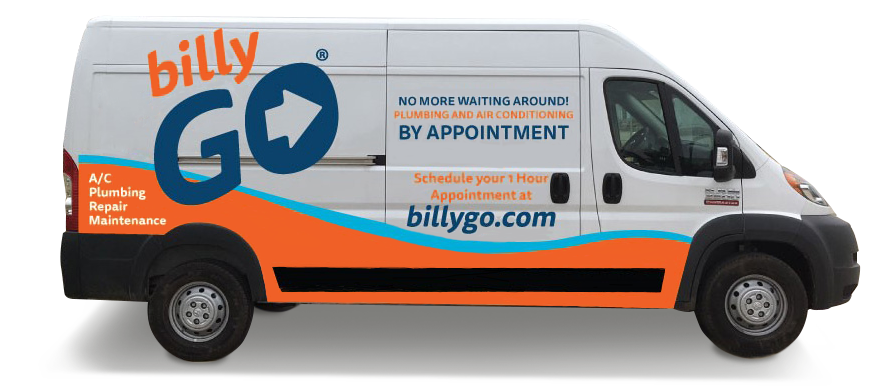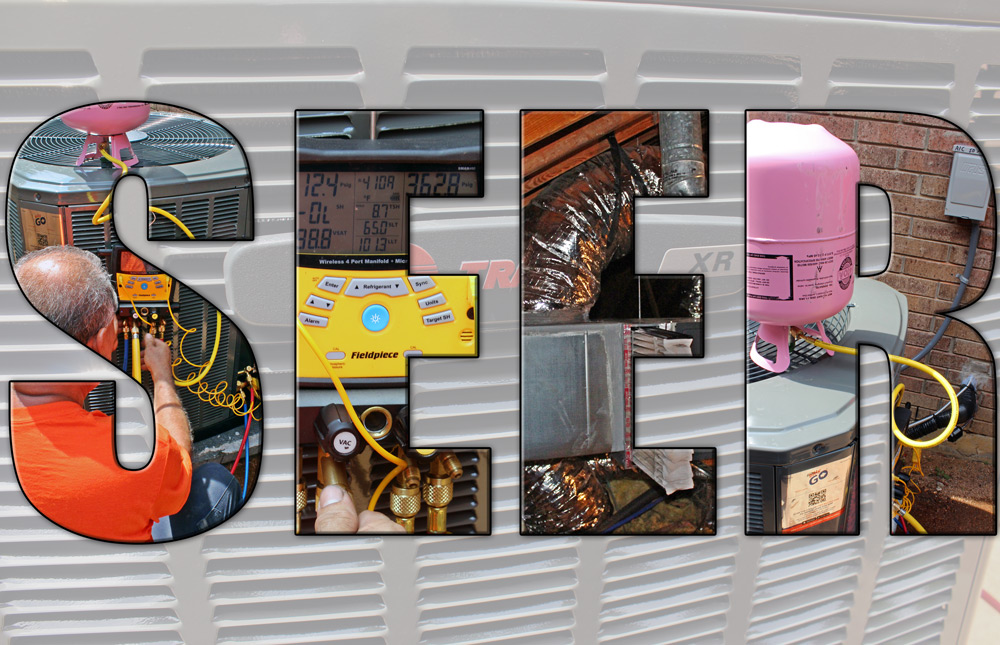
You’ve probably heard about SEER rating even if you haven’t purchased an air conditioning system recently. It’s an acronym for Seasonal Energy Efficiency Rating. SEER has been around for decades, dating back to when people were buying homes (perhaps with glorious Seventies staples like shag carpeting and avocado green kitchens).
In recent years, the SEER rating has become a bigger part of the conversation. Part of the reason is that energy prices have risen considerably, hitting us all in the wallet. At the same time, AC units have pushed forward dramatically in efficiency, delivering lower energy bills due to SEER numbers that 25 years ago would’ve felt nearly as much like science fiction as Star Wars.
Everyone wants lower energy bills, but most people just aren’t aware of how much more comfortable their homes will be with high-efficiency air conditioning. Once they make the change, they tell us their only regret was waiting so long to do it.
It’s a given you will be much more comfortable and have lower operating costs with high-efficiency equipment. But when replacing a central air conditioner, there’s more to consider than just SEER values. You’ll want to know what a good number is, of course, but also:
- how high a rating you’ll need,
- whether the highest rating is always best,
- other costs involved,
- what might be the SEER rating sweet spot, and
- the important differences of single-speed, two-speed, and variable-speed compressors and fans.
A Simple Explanation of SEER Rating
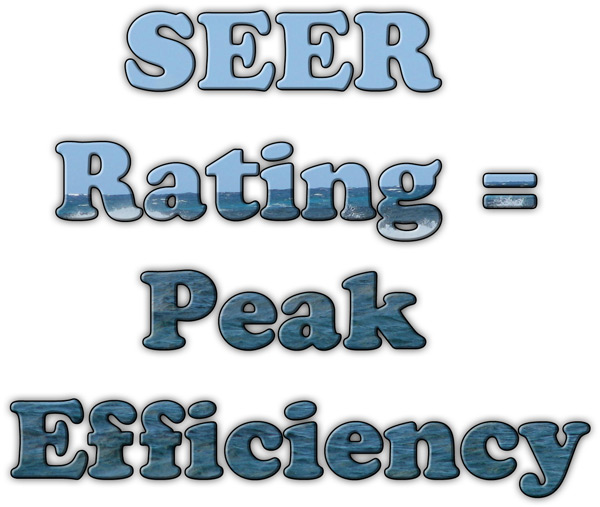 Before the “What SEER number should I buy?” question is asked, let’s lay out the definition. The SEER rating of a central air unit is the cooling output over a typical cooling season divided by the energy used during the season.
Before the “What SEER number should I buy?” question is asked, let’s lay out the definition. The SEER rating of a central air unit is the cooling output over a typical cooling season divided by the energy used during the season.
The SEER rating ( ratio) is calculated using constant indoor temperature and a variety of outdoor temperatures ranging from 60 to more than 100 degrees to simulate a cooling season. The higher the SEER ratio, the more efficiently a unit can operate.
Important note: The SEER “score” is a maximum rating, meaning that it’s what is achieved when a central air conditioning unit is operating at peak efficiency. It is not the rating that the unit achieves constantly. You can think of SEER like a car’s miles-per-gallon rating. A car’s MPG average is what you might experience, but it will vary depending on things such as whether you drive in bumper-to-bumper traffic or with a NASCAR lead foot.
What is a Good SEER Number?
Back in the Eighties, the maximum efficiency rating of air conditioning units was often 8 or less and there was no national standard. But in 1992, the U.S. Department of Energy began requiring a minimum SEER rating for a new HVAC system. It has been updated over the years to move to increasingly higher efficiency AC systems:
- 1992: 10
- 2006: 13
- 2015: 14*
*The 2015 requirement is for states that the Department of Energy considers to have high cooling needs in the Southeastern Region (Alabama, Arkansas, Delaware, Florida, Georgia, Hawaii, Kentucky, Louisiana, Maryland, Mississippi, North Carolina, Oklahoma, South Carolina, Tennessee, Texas, and Virginia) and Southwestern Region (Arizona, California, Nevada and New Mexico). For all other states, 13 SEER is the minimum rating.
Why the Highest SEER Rating Is Not Always Best
While the minimum SEER ratings for new AC units in the United States are 13 and 14, some new central air conditioning systems have SEER values as high as 26. Most air conditioning units, however, are in the 13 – 22 range.
But the highest SEER values are not the right choice for everyone. Not even for most people, considering that AC units with the highest SEER numbers are considerably more expensive to purchase. Air conditioning repair with the units can also be more expensive because their higher-efficiency compressors and fan motors are more expensive than on AC units with lower SEER ratings.
How High a SEER Number Do You Need?
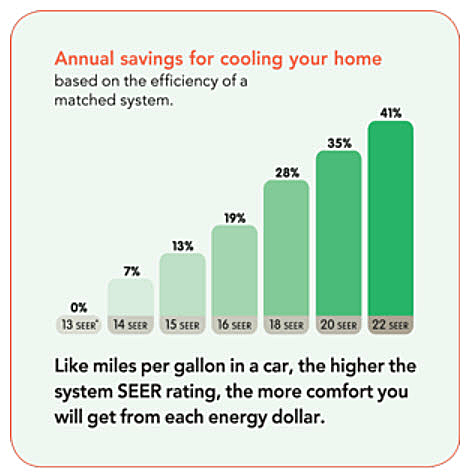 The U.S. Department of Energy’s minimum SEER requirement means that every air conditioning unit manufactured now is more efficient — often far more efficient — than those from only 15 years ago. And although a 13 or 14 SEER AC unit is considerably less efficient than a model with a SEER rating of 20, in some cases the lower SEER is the more prudent financial choice.
The U.S. Department of Energy’s minimum SEER requirement means that every air conditioning unit manufactured now is more efficient — often far more efficient — than those from only 15 years ago. And although a 13 or 14 SEER AC unit is considerably less efficient than a model with a SEER rating of 20, in some cases the lower SEER is the more prudent financial choice.
There are a lot of variables involved, one of the largest being the amount of cooling required in the home.
Even in similar-sized homes in a particular neighborhood, operating in the same climate, there can be dramatic differences in cooling demand. That’s because a comfortable thermostat setting for one person might be five degrees different than his or her neighbor. In addition, some homes are far more energy-efficient than others through better insulation, ductwork, ventilation, and other factors. (Here are some energy-saving tips from the Department of Energy).
Each home and homeowner is different, but here are some guidelines:
- Homeowners in hotter parts of the country will get a bigger return on their investment in a higher-SEER model, such as a 16, 17 or 18 SEER. In parts of the country with milder summers, where cooling bills are rarely very high, homeowners would likely never see enough energy savings to financially justify purchasing an AC unit with a SEER rating of 20 or higher.
- Although a SEER rating of 23 or more is very impressive from a standpoint of operational efficiency, only in rare cases would such an air conditioning system make sense financially, even in hotter climates. Because of the up-front expense of the highest-SEER units, a homeowner is unlikely to have enough years of use of the AC unit to offset the cost. Having a 25 SEER AC unit is like driving a luxury car versus a modest, dependable one. Is the luxury model better? Sure. But it’s not the better financial decision (and it’s a lot easier to show off your Mercedes than your AC unit).
- Search “SEER savings calculator” and you’ll find many calculators on the Internet. Some can be useful, but always remember that an AC SEER rating is a maximum efficiency for a unit and not what is expected during all times of operation. When considering your central air conditioner replacement cost, as well as what will maximize the comfort level in your home’s interior and in your wallet, consult a licensed air conditioning professional who knows your area best.
The SEER Sweet Spot
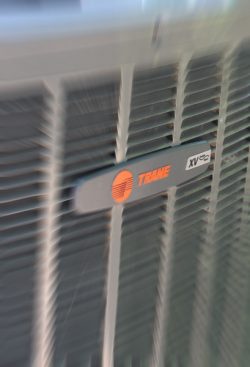 It’s impossible to have a rule of thumb in a world with so many different thumbs. But at least for most homeowners, especially those who live in warmer climates, there seems to be a SEER rating sweet spot. And that rating is (drumroll please) …
It’s impossible to have a rule of thumb in a world with so many different thumbs. But at least for most homeowners, especially those who live in warmer climates, there seems to be a SEER rating sweet spot. And that rating is (drumroll please) …
17 or 18 SEER.
For the warm-climate states, the federal minimum is 14 SEER, and for some homes, this is a perfectly reasonable choice. After all, 14 SEER offers an improvement over what was often installed just five years ago. But the 14 SEER AC units don’t take advantage of the latest technology, and the same is true for most 15 and 16 SEER systems, although they are more than twice as efficient as some HVAC units still in operation today.
The reason why the next bump in SEER rating hits the sweet spot is because of what often comes with the 17 or 18 SEER AC unit: the two-speed or variable-speed compressor (and when replacing a complete HVAC system, a variable speed blower fan, too).
Two-Speed and Variable-Speed Compressors
Most central air conditioners in the United States still use a single-stage compressor, which was the standard for decades. With a single-stage compressor, an HVAC unit turns on when the room temperature exceeds the thermostat setting and then operates at 100 percent capacity until the desired temperature is reached. It’s either off or it’s on full-blast. In terms of the car comparison, it’s like driving a car with no accelerator pedal to adjust your speed to driving conditions.
Two-speed and variable-speed compressors work differently.
A two-stage compressor, also known as a dual-stage compressor, can operate at full capacity when the cooling demand is high and at a lower setting when demand is lower. A variable-speed compressor takes it to another level, with the ability to operate at a range of levels from about 25 percent of capacity to full power.
Advantages of Two-Speed and Variable-Speed Compressors
The two-speed and variable-speed compressors offer what most homeowners seek most from an air conditioning unit:
- Increased comfort
- Lower energy bills
Here’s how air conditioning units with two-speed compressors, and to a greater extent, variable-speed compressors, achieve those benefits. For simplicity sake, we’ll refer to them all as variable-speed units.
 Increased comfort: When an HVAC system is running, it’s pulling the humidity out of the air in your home. So, whenever the system isn’t running, the humidity rises. A variable-speed HVAC system’s longer run times allow it to dehumidify your home more effectively, adding a refreshing crispness to the air. And while a home with single-stage air conditioning will alternate between blasted cold air and no cooling at all, a home with a variable-speed AC unit benefits from a steady stream of cold air.
Increased comfort: When an HVAC system is running, it’s pulling the humidity out of the air in your home. So, whenever the system isn’t running, the humidity rises. A variable-speed HVAC system’s longer run times allow it to dehumidify your home more effectively, adding a refreshing crispness to the air. And while a home with single-stage air conditioning will alternate between blasted cold air and no cooling at all, a home with a variable-speed AC unit benefits from a steady stream of cold air.
The longer-run cycles of variable-speed AC units also help improve the overall air quality in your home. That’s because the lower humidity can help prevent mold growth in bathrooms, kitchens, ductwork and other damp areas of the home.
Lower energy bills: A single-stage HVAC unit can only run at 100 percent, so it turns off and on continuously during the day. You’ve probably heard how loud these units can be, especially the older units when they turn on. The constant restarting of the compressor and getting it to full blast uses more energy than a variable-speed HVAC unit doing longer runs at low energy levels – and it puts more wear and tear on the compressor.
In addition, variable-speed AC units are better at dehumidifying the air, allowing a home to feel more comfortable at a higher thermostat setting, saving more money. Many homeowners who kept the thermostat in the low 70s with older air conditioners find that with a variable-speed 17- or 18-SEER air conditioner they are more comfortable with the thermostat set at 78 or 79.
Other Things to Consider with SEER Rating
- Air conditioning units with higher SEER ratings are often much quieter than those with lower SEER ratings. That’s especially true for units with variable-speed compressors because they have quieter fans and don’t always operate at full capacity.
- As with any home improvement, homeowners should consider how long they plan to stay in their home. Models with higher SEER ratings can offer substantial savings on energy bills, but it could take a few years to offset the up-front costs. That considered, a new AC unit with an impressive SEER value may give your home a marketing advantage in a competitive real estate market. Regardless, it’s a better choice for a homeowner planning to live in the home for a while.
- Air conditioning units with the highest SEER ratings, especially 20 or higher, can have more expensive parts. Extended warranties often cover 10 years on labor (sometimes 12 years) and 10 years on parts. Homeowners are smart to consider such a warranty, as well as maintenance plans that provide regular inspections that can prevent problems or catch them at early stages.
- Perhaps the environment should be higher on this li because we’ve only got one Earth to share. But all modern air conditioning units are far more Earth-friendly than their predecessors, and the government-mandated switch from R-22 refrigerant to R-410A is of great benefit to the environment. That all being said, the more efficient an AC unit can be in its energy use, which is reflected by its SEER rating, the better it is for the environment.
Conclusion
Air conditioners are a modern marvel, and they are becoming even more amazing as advances in technology push their efficiency to unprecedented levels. Models with SEER ratings well over 20 are now available, an amazing improvement over the single-digit SEER ratings of some AC units still in operation.
But while air conditioners with the highest SEER ratings will draw interest from some homeowners, AC units with slightly lower SEER ratings are a very reasonable choice. Models with SEER ratings of 17 or 18 are huge steps forward from most models that were installed just a few years ago, and they offer homeowners the combination of saving money, adding to the comfort level of their homes and doing something good for the environment.
When buying a new HVAC system, the first step should be to contact an air conditioning professional who can help you determine the type and size of AC unit that’s right for your needs. After all, your air conditioning “sweet spot” might be different than that of your neighbor.
So, are you ready to find the perfect air conditioning unit with the best SEER rating for you? billyGO can help you with the right decision.
